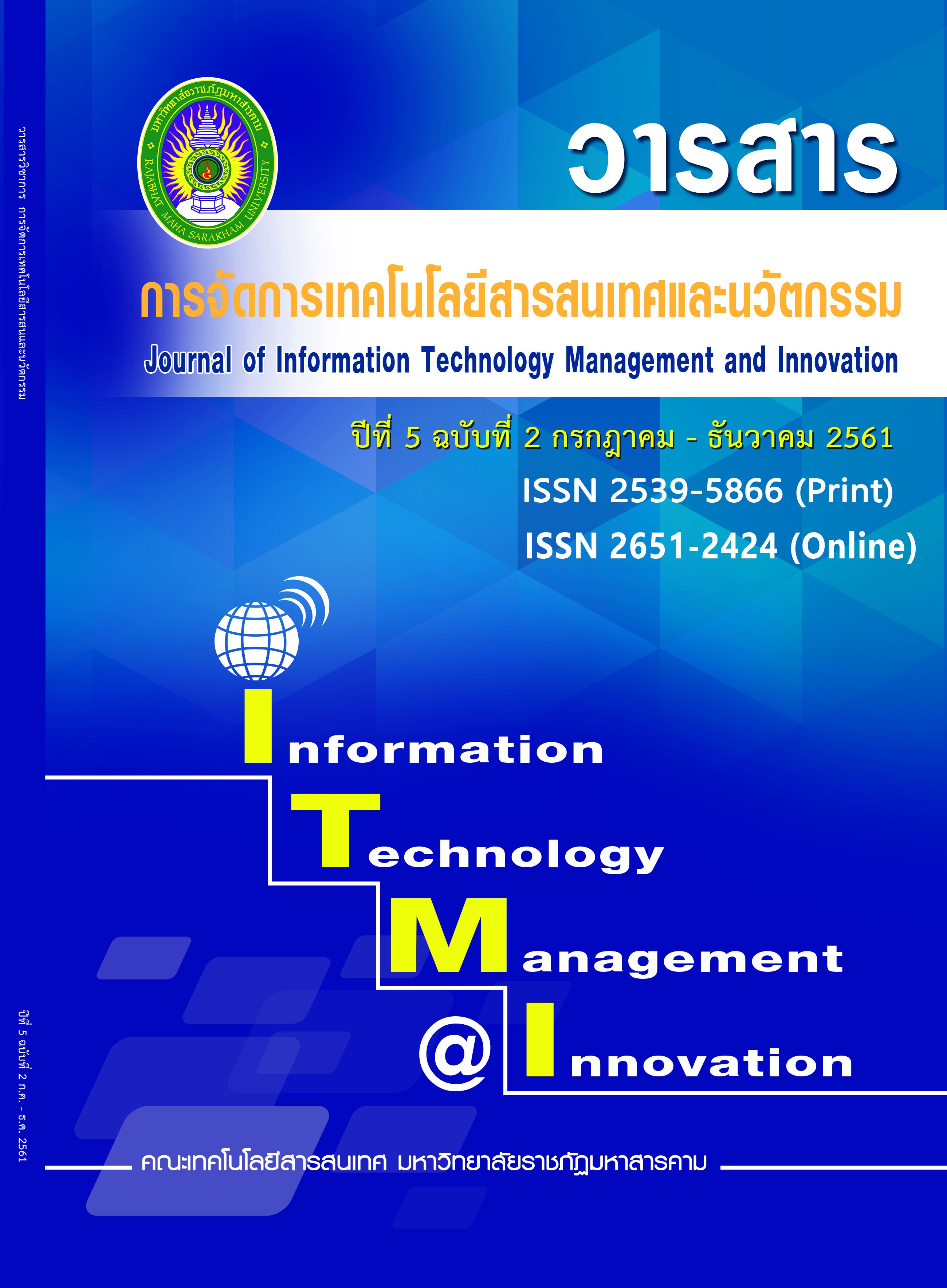รูปแบบการนิเทศแบบ พีไอพีอาร์อี ที่ส่งเสริมทักษะการสอนคิดวิเคราะห์ ตามหลักปรัชญาของเศรษฐกิจพอเพียงของครูโรงเรียน สังกัดองค์การบริหารส่วนจังหวัดมหาสารคาม
Main Article Content
บทคัดย่อ
การวิจัยครั้งนี้ มีวัตถุประสงค์เพื่อ 1) ศึกษาสภาพปัจจุบัน ปัญหา และความจำเป็นของการพัฒนาการสอนคิดวิเคราะห์ 2) พัฒนาและตรวจสอบคุณภาพของรูปแบบการนิเทศ 3) ทดลองใช้รูปแบบการนิเทศ และ 4) ประเมินและปรับปรุงรูปแบบการนิเทศ การดำเนินการวิจัยแบ่งออกเป็น 4 ระยะ ดังนี้ ระยะที่ 1 ศึกษาสภาพปัจจุบัน ปัญหา และความจำเป็นของการพัฒนาการสอนคิดวิเคราะห์ กลุ่มเป้าหมายที่ทำการศึกษา ได้แก่ ผู้เชี่ยวชาญ จำนวน 5 คน ที่ได้จากการเลือกแบบเจาะจง เครื่องมือ ได้แก่ แบบสัมภาษณ์กึ่งโครงสร้าง ระยะที่ 2 การพัฒนาและตรวจสอบคุณภาพของรูปแบบ การจัดทำร่างรูปแบบการนิเทศ ประชากร ได้แก่ ผู้อำนวยการ รองผู้อำนวยการโรงเรียน และครู จากโรงเรียนสังกัด อบจ.มหาสารคาม ทั้งหมด 20 โรงเรียนๆ ละ 5 คน รวมทั้งหมด 100 คน กลุ่มตัวอย่าง ได้แก่ ผู้อำนวยการ รองผู้อำนวยการโรงเรียน และครู จำนวน 4 โรงเรียนๆ ละ 5 คน รวมทั้งหมด 20 คน ที่ได้จากการเลือกแบบเจาะจง การตรวจสอบความสมเหตุสมผลเชิงทฤษฎี ความเป็นไปได้ และความสอดคล้องของรูปแบบการนิเทศ โดยผู้เชี่ยวชาญ จำนวน 5 คน เครื่องมือ ได้แก่ แนวการฝึกอบรมเพื่อให้ความรู้พื้นฐาน แบบบันทึกการประชุมเชิงปฏิบัติการ แบบบันทึกการสนทนากลุ่มผู้เชี่ยวชาญ เครื่องมือที่ใช้ในการตรวจสอบคุณภาพของรูปแบบ และเครื่องมือที่ใช้ในการเก็บรวบรวมข้อมูล ระยะที่ 3 การทดลองใช้รูปแบบการนิเทศ เลือกทำการทดลองที่โรงเรียนนาข่าวิทยาคม ประชากร ได้แก่ ครูหัวหน้ากลุ่มสาระการเรียนรู้ จำนวน 7 คน และครูผู้สอน จำนวน 35 คน นักเรียน จำนวน 751 คน รวมประชากรทั้งหมด 794 คน กลุ่มตัวอย่าง ได้แก่ ครูผู้นิเทศ จำนวน 7 คน ครูผู้รับการนิเทศ จำนวน 8 คน ที่ได้จากการเลือกแบบเจาะจง นักเรียน ระดับชั้นละ 1 ห้องเรียน จำนวน 232 คน ที่ได้จากการสุ่มแบบกลุ่ม (Cluster Random Sampling) รวมจำนวนกลุ่มตัวอย่างทั้งหมด 247 คน เครื่องมือ ได้แก่ เครื่องมือที่ใช้ในการเก็บรวบรวมข้อมูล และเครื่องมือที่ใช้ในการนิเทศ ระยะที่ 4 การประเมินและปรับปรุงรูปแบบ กลุ่มเป้าหมาย ที่ทำการศึกษา ได้แก่ ฝ่ายบริหารโรงเรียน จำนวน 5 คน ครูผู้นิเทศ จำนวน 7 คน และครูผู้รับการนิเทศ จำนวน 8 คน รวมทั้งหมด จำนวน 20 คน เครื่องมือ ได้แก่ แบบสอบถามการวิเคราะห์ข้อมูลใช้ ค่าร้อยละ ค่าเฉลี่ย ค่าเบี่ยงเบนมาตรฐาน ค่าดัชนีประสิทธิผล (E.I.) ค่า t-test แบบ dependent และการวิเคราะห์เนื้อหา
ผลการวิจัย พบว่า
- สภาพปัจจุบัน ปัญหา และความจำเป็นของการพัฒนาการสอนคิดวิเคราะห์ของครูส่วนมากเกิดจากครูผู้สอนที่ไม่เข้าใจหลักสูตร เกิดจากพฤติกรรมของผู้เรียนที่ไม่ใฝ่รู้ ใฝ่เรียน ขาดแรงจูงใจทางการเรียน ขาดความเอาใจใส่ กำกับ นิเทศติดตามของผู้บริหาร และการบริหารจัดการที่ไม่มีประสิทธิภาพ จากสภาพปัญหาดังกล่าว ส่งผลต่อคุณภาพของผู้เรียน จึงมีความจำเป็นอย่างยิ่งในการพัฒนาทักษะการสอนคิดวิเคราะห์ของครู
- รูปแบบการนิเทศแบบพีไอพีอาร์อี ประกอบด้วย กระบวนการดำเนินงาน 5 ขั้นตอน ได้แก่ 1) การวางแผน 2) การให้ความรู้ 3) การดำเนินการ ประกอบด้วย (1) การประชุมก่อนการสังเกตการสอน (2) การสังเกตการสอน (3) การประชุมหลังการสังเกตการสอน 4) การสะท้อนคิด และ 5) การประเมินผล โดยมีการกำกับ ติดตาม อย่างต่อเนื่องทุกขั้นตอน และผลการตรวจสอบคุณภาพของรูปแบบการนิเทศ โดยผู้เชี่ยวชาญ 5 คน พบว่า มีคุณภาพ และมีองค์ประกอบครบถ้วน สมบูรณ์
- ผลการตรวจสอบประสิทธิผลของรูปแบบการนิเทศแบบ พีไอพีอาร์อี โดยการนำไปใช้ในโรงเรียน พบว่า 1) ครูผู้นิเทศมีสมรรถภาพในการนิเทศแบบชี้แนะทางปัญญาอยู่ในระดับสูงมาก และมีความรู้ความเข้าใจเกี่ยวกับการสอนคิดวิเคราะห์ตามหลักปรัชญาของเศรษฐกิจพอเพียงเพิ่มขึ้น มีค่าดัชนีประสิทธิผล เท่ากับ 0.8529 คิดเป็นร้อยละ 85.29 2) ครูผู้รับการนิเทศ มีความรู้ ความเข้าใจ เกี่ยวกับการสอนคิดวิเคราะห์ตามหลักปรัชญาของเศรษฐกิจพอเพียงเพิ่มขึ้น มีค่าดัชนีประสิทธิผล 0.8507 คิดเป็นร้อยละ 85.07 สมรรถภาพในการสอนคิดวิเคราะห์ตามหลักปรัชญาของเศรษฐกิจพอเพียง อยู่ในระดับสูงมาก (ร้อยละเฉลี่ย 85.49) และความพึงพอใจต่อรูปแบบการนิเทศ อยู่ในระดับสูงมาก 3) นักเรียนทุกทุกห้องเรียนที่ได้รับคัดเลือกเป็นกลุ่มตัวอย่าง มีผลการเรียนรู้ที่เกิดจากการสอนคิดวิเคราะห์ในชั้นเรียนของครู ผู้รับการนิเทศก่อนและหลังการใช้รูปแบบการนิเทศ แตกต่างกัน อย่างมีนัยสำคัญทางสถิติที่ระดับ 0.05 โดยหลังการใช้รูปแบบการนิเทศ มีคะแนนเฉลี่ยสูงกว่าก่อนการใช้รูปแบบการนิเทศ
- ผลการประเมินรูปแบบการนิเทศในภาพรวม พบว่า มีความเหมาะสมอยู่ในระดับมากที่สุด มีค่าเฉลี่ยเท่ากับ 4.70 เมื่อพิจารณาเป็นรายด้าน พบว่า ด้านการบรรลุวัตถุประสงค์ของการดำเนินงาน มีความเหมาะสมโดยรวมอยู่ในระดับมากที่สุด มีค่าเฉลี่ยเท่ากับ 4.80 ด้านผลกระทบของการดำเนินงาน มีความเหมาะสมอยู่ในระดับมากที่สุด มีค่าเฉลี่ยเท่ากับ 4.70 และด้านความคุ้มค่าของการดำเนินงาน มีความเหมาะสมอยู่ในระดับมากที่สุด มีค่าเฉลี่ยเท่ากับ 4.60
Article Details
เอกสารอ้างอิง
[2] เบญจลักษณ์ น้ำฟ้า. (2558). ลดเวลาเรียน เพิ่มเวลารู้. สืบค้นจาก http://www.bnc.ac.th/knowledge/wp-content upload.
[3] สุทัศน์ เอกา. (2556). ทำไมต้อง Teach Less Learn More. สืบค้นจาก http://wwwkruthai40.ning.com/proflies/blogs
[4] ทิศนา แขมมณี. (2556). ศาสตร์การสอน: องค์ความรู้เพื่อการจัดกระบวนการเรียนรู้ที่มีประสิทธิภาพ (พิมพ์ครั้งที่ 7). กรุงเทพฯ: สำนักพิมพ์แห่งจุฬาลงกรณ์มหาวิทยาลัย.
[5] กุลยา ตันติผลาชีวะ. (2551). การจัดกิจกรรมการเรียนรู้สำหรับเด็กปฐมวัย. กรุงเทพฯ: เบรน-เบสบุ๊คส์.
[6] ไพฑูรย์ สินลารัตน์. (2557). ทักษะแห่งศตวรรษที่ 21 ต้องก้าวให้พ้นกับดักของตะวันตก. กรุงเทพฯ: ธุรกิจบัณฑิต.
[7] เวชฤทธิ์ อังกนะภัทรขจร. (2555). การประยุกต์ใช้แนวคิด Teach Less, Learn More (TLLM) สู่การจัดการเรียนรู้ในชั้นเรียน คณิตศาสตร์. วารสารศึกษาศาสตร์, 23(1), 1-11.
[8] วิทยากร เชียงกูล. (2552). การศึกษากับการพัฒนาเศรษฐกิจและสังคม. สืบค้นจาก http://www.onec.go.th/admin/admin_cal
[9] เยาวพา เดชะคุปต์. (2542). การบริหารและการนิเทศการศึกษาปฐมวัย. กรุงเทพฯ: แม็ค.
[10] สงัด อุทรานันท์. (2530). การนิเทศการศึกษา หลักการ ทฤษฎีและปฏิบัติ (พิมพ์ครั้งที่ 2). กรุงเทพฯ: ภาควิชาบริหารการศึกษา คณะครุศาสตร์ จุฬาลงกรณ์มหาวิทยาลัย.
[11] ชนิพรรณ จาติเสถียร. (2557). การชี้แนะทางปัญญาเพื่อการพัฒนาครู. วารสารศึกษาศาสตร์ มสธ., 7(2), 28-35.
[12] วัชรา เล่าเรียนดี. (2550). ศาสตร์การนิเทศการสอนและการโค้ช (พิมพ์ครั้งที่ 12). นครปฐม: คณะศึกษาศาสตร์ มหาวิทยาลัยศิลปากร วิทยาเขตพระราชวังสนามจันทร์.
[13] ยุพิน ยืนยง. (2553). การพัฒนารูปแบบการนิเทศแบบหลากหลายวิธีการเพื่อส่งเสริมสมรรถภาพการวิจัยในชั้นเรียนของครู
เขตการศึกษา 5 อัครสังฆมณฑล. นครปฐม: สาขาหลักสูตรและการสอน ภาควิชาหลักสูตรและการสอน บัณฑิตวิทยาลัย มหาวิทยาลัยศิลปากร.
[14] แววดาว พานดวงแก้ว. (2555). การพัฒนาครูด้านการจัดการเรียนรู้เพื่อส่งเสริมทักษะการคิดวิเคราะห์ของนักเรียนโรงเรียนเวียงสะอาดพิทยาคม องค์การบริหารส่วนจังหวัดมหาสารคาม. มหาสารคาม: โรงเรียนเวียงสะอาดพิทยาคม องค์การบริหารส่วน จังหวัดมหาสารคาม.
[15] ก่อ สวัสดิพานิชย์. (ม.ป.ป.). แนวคิดและทฤษฎีเบื้องต้นเกี่ยวกับการบริหารการศึกษา. กรุงเทพฯ: สำนักงานปลัดกระทรวงศึกษาธิการ.
[16] Schoderbek, Peter, Charles, G., & Kefalas, Asterios. (1990). Management System: Conceptual Consideration (4th ed.). Richard D.Irwin, Homewood, III.
[17] Spears, Harold. (1976). Improving the Supervision of Instruction. New York: Prentice-Hall..
[18] อรศรี งามวิทยาพงศ์. (2549). กระบวนการเรียนรู้ในสังคมไทย และการเปลี่ยนแปลงจากยุคชุมชนหลังยุคพัฒนาความทันสมัย. กรุงเทพฯ: วิทยาลัยการจัดการทางสังคม (วจส.).
[19] สุปรียา ศิริพัฒนากุลขจร. (2552). การพัฒนาการเรียนรู้วิชาเครื่องมือวัดอุตสาหกรรมและควบคุมโดยใช้การเรียนรู้แบบร่วมมือ เทคนิค STAD. สืบค้นจาก http://www.dpu.ac.th/graduate/upload/content/files
[20] Costa, Arthur., & Garmston, Robert. (2002). Cognitive Coaching: A Foundation for Renaissance Schools
(2nd ed.). Sandy, UTha: TeachStream/Video Journal of Education.
[21] นภดล ร่มโพธิ์. (2552). การประเมินความสำเร็จของระบบการประเมินผลการปฏิบัติงานองค์กร. สืบค้นจาก www.jba.tbs.tu.acth


